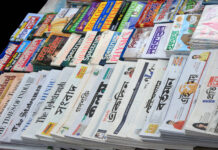
More research is needed into the stories of white British Muslim converts, writes Sadia Habib.
In October 2006, I interviewed a white British female, Year 11 student who had researched Islam for eight months and then decided to convert to Islam. Alice’s parents were devout Christians, and she explained that they were not too pleased with her conversion to Islam, hoping it was merely a phase that teenagers go through. She had become interested in Islam as she had Muslim friends whose way of life she found intriguing, and thus, she began to read up about their religion. As she learned more about Islam, she felt a connection and found that many previously unanswered questions were being resolved. Therefore, she decided to convert to Islam.
She decided to wear the hijab, which was a significant marker of her new identity. One of the reasons, she explained, was that because she was not born into the religion, she felt she had to prove her commitment to everyone around her. She found that her white non-Muslim school friends were supportive of her decision. Interestingly, none of her school teachers had directly asked her about her decision to convert to Islam.
Since becoming a Muslim, she loved her Monday morning Religious Education (RE) lessons, as there were many devout Christian students in the class and she could argue her position with them in a “friendly debate”. Moreover, she enjoyed researching and learning about Islam in preparation for RE lessons.
Sense of “belonging”
Alice highlighted how her conversion to Islam gave her a sense of belonging, but at the same time she had become very aware of the ethnic and cultural heritage that other Muslims (born into Islam) can rely on. This act of converting to Islam had provided her with a symbolic space to belong, but it also made Alice aware of how sometimes she did not belong: “It puts a smile on my face when I see another white Muslim. I haven’t seen many of us”. She discussed changes since adopting this new identity:
“I’m thinking about every little thing I do…every little step I take. Is that haram or halal? Before when I do good things, I’ll do someone a favour or I’ll go out of my way to do something and I’ll be like “Yeah, that was alright”. But now I’ll be blessed for doing it as well. It’s more encouraging. I’ve been concentrating on doing a lot of better things. I used to get a joy out of threatening people…I used to feel my power…I wasn’t a bully, but I would talk harshly to people who were smaller than me. Whereas now I don’t. I feel like that’s not the way to do it.”
Subscribe to our newsletter and stay updated on the latest news and updates from around the Muslim world!
Identity and “Britishness”
It is fascinating to learn about the complexities and nuances of such reflective identity work, and how it impacts upon Alice’s everyday life. She explains how she has essentially adopted a new internal framework of reference that values strong family bonds, modest dress and education.
Grayson Perry’s new exhibition at the National Portrait Gallery also presents a White British female convert to Islam. Who are you? depicts 14 modern day Britons and their complex identities. Kayleigh Khosravi, the subject of a silk screen-print with the title The Ashford Hijab, spent time with Grayson Perry in order for him to better understand her identity as a White Muslim convert
Political and media rhetoric almost always focuses on how Islam is incompatible with Britishness, and how Muslims must work harder to integrate (often code for assimilate). What about White British Muslims? With the emergence of new identities of White British Muslims, more research is needed into the stories of converts to understand how they are able to position themselves as both British and Muslim, in order for us to develop discussions on what this means for modern multicultural Britain and the discourse of integration/assimilation.
Sadia Habib taught English at Key Stages 3, 4 and 5. She is a PhD candidate in Educational Studies at Goldsmiths University of London. She is also an editor and the main Book Review editor for The Sociological Imagination.
You can follow Sadia on Twitter @educ_research



















